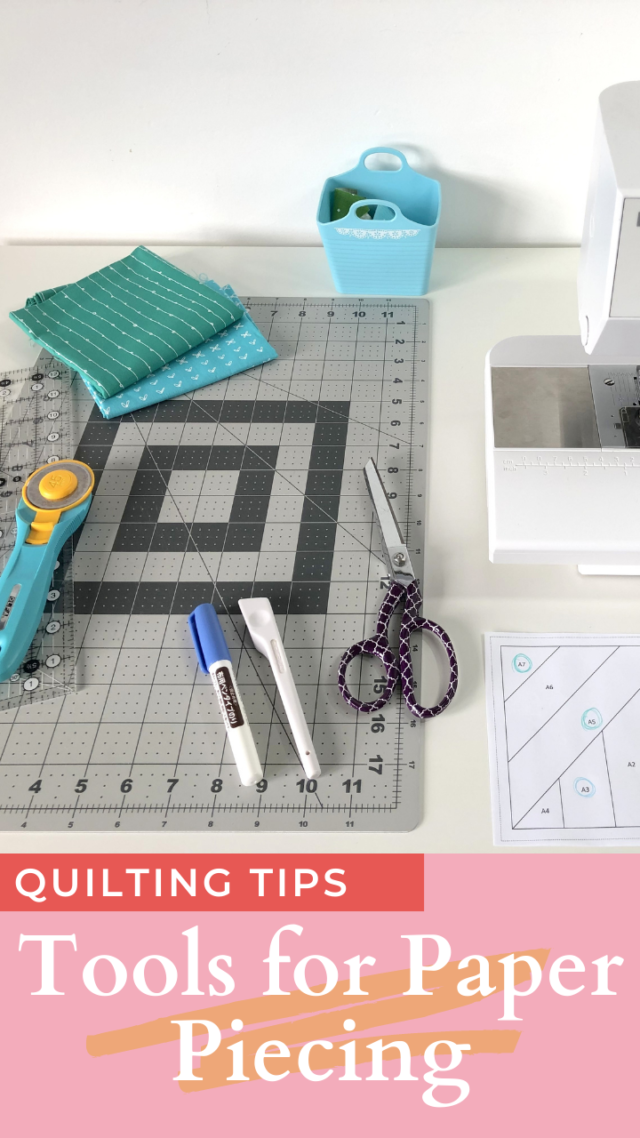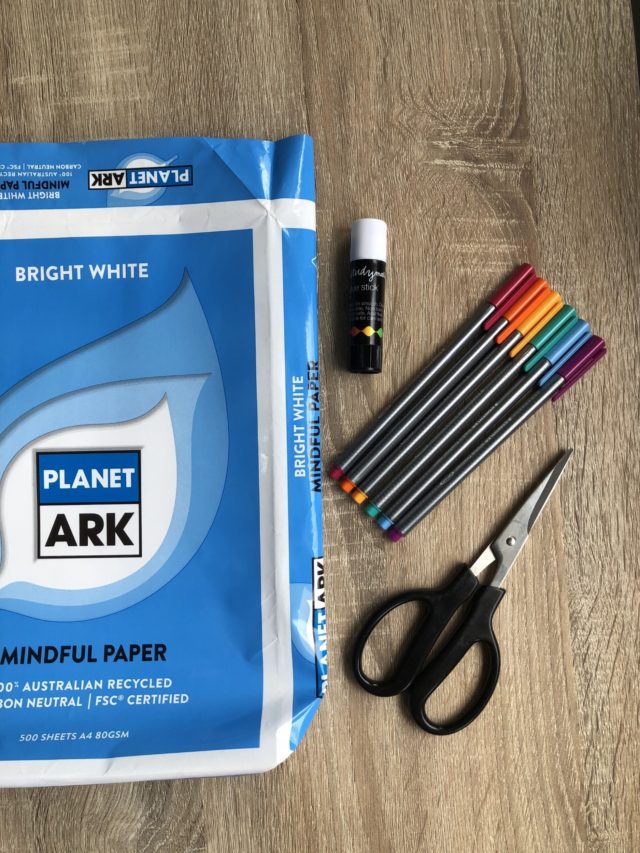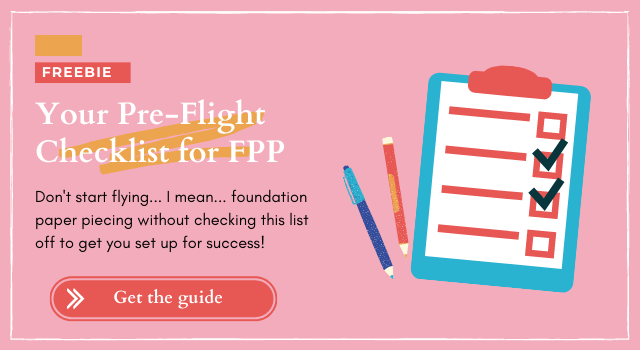I love foundation paper piecing – it’s so accurate, you can create amazing designs without fiddling with cutting out odd shapes from your fabric with templates, and it’s just like painting with numbers… but with fabric! Next up for the Mini Masterpieces QAL, we’re tackling foundation paper piecing, and because this is one of those techniques that quilters tend to be a bit wary of, I’m starting the prep work now to help build your confidence up ahead of time.
And I’m also here to help prep your sewing kit… because here’s four tools and supplies you’re going to want to have on hand for foundation paper piecing that you might not have in your sewing room already. And not just any old tool, these are four things you can get from any office supply store (or perhaps even during your weekly grocery shop!), which means they’re cheap and easy to get no matter where you live. Gotta love that!
Washable glue stick
There are glue pens specifically designed to use with fabric – they’re washable, non-toxic, and a nice, small size. These are perfect for using to glue baste English paper piecing shapes and can certainly be used to help baste in foundation paper piecing, especially when the segments are little!
But I prefer to use a regular washable glue stick when foundation paper piecing as it’s much cheaper, and unless the segments are really little, you use a bit when making lots of blocks. I still buy the smaller size for easier wielding and swiping on the paper, but I can swipe away without worrying about how much I’m using up (because I also buy a bulk pack – saves money, and I’m not about to run out).
Coloured pens or markers
Now this is a fun one to keep on hand! Who doesn’t love buying new, pretty stationery?! These will help you organise your fabric and templates so that you know what fabric goes where.
And yes, this does indeed mean that I am 100% enabling you to go buy a set of rainbow pens or markers just for your sewing room. You can absolutely just grab the kids’ set of coloured pencils as needed. But, you know, if you wanted an excuse to buy some pretty pens, here’s your chance 😉
Regular copy paper
Guess what?! You don’t need to use fancy paper for foundation paper piecing. There are certainly fancier options you can use, but I stick with regular copy paper as it’s cheap and easy, and it does the job beautifully. I recommend buying a recycled paper option, and then don’t forget to recycle the papers when you finish – these little choices add up to help our world.
Heads up – basic paper sizes vary around the world. Canada and USA primarily use Letter paper, while most of the rest of the world uses A4. All good foundation paper piecing designers will take that into account and format their designs to work on either size of paper. So just buy what size you normally use in your printer and you’re good to go.
Paper scissors
You know all those memes about what happens to family members who use fabric scissors for paper, cardboard, wire, and even pizza?! Don’t let that happen to you!
Cutting anything but fabric with our precious fabric scissors will blunt the blades much more quickly than usual, and will make it harder to get a sharp and easy cut with fabric. Make sure you have a pair of regular scissors to cut out the paper templates, and make sure they look different from your fabric scissors, otherwise mark them somehow so you know the difference.



Sherri says
I like your list of essentials! I would suggest that an “Add a Quarter” ruler is also important, I wouldn’t do FPP without it. I’m also a bit lazy and I like that it easily abuts up to the seam without me having to peer through a ruler to get that nice quarter-inch seam.
shelly says
Agree! You HAVE to have the add a quarter ruler!
Alyce says
It’s definitely a good tool! Although I do go back and forth on how much I use mine.
Jackson says
Sherri,
I agree 100%! I couldn’t live without mine. I have had one since the beginning of my Foundation Paper Piecing journey and cannot imagine not having one.
Kathy says
I found “newsprint ” paper in a 500 sheet team for less than the price of one package of printer paper…. check it out!
Alyce says
Definitely handy when making really complex patterns! But can be tricky to print on, so I don’t recommend it for total beginners 😉
Maree Adams says
I am one of those people you refer to who shy away from foundation piecing so I am committing to your tutorials on FPP. I am interested in your response to the question re Add a Quarter Ruler. Would you recommend it and will you explain how to use it in your instructions please?
Alyce says
It’s a handy tool to have, but as with all my “let’s learn a new technique” recommendations, start with what you have. And if you do enjoy FPP but the trimming stage is a little tricky, then you can upgrade! 🙂
Pat says
school supply stores have reams of newsprint which work wonderfully for FPP, The paper easily tears out and is only a fraction of the cost.
Carol Piccini says
do you know if this fits in a copier?
Johnnie says
Runs through copier perfectly – just get the 8 1/2 x 11 newsprint by the 500 page package
Nanette says
Hi Johnnie, do you purchase this locally as shipping makes it cost prohibitive?
Johnnie says
Be sure to do size check no matter what you print on
Alyce says
Ha, not here in Australia, it’s not 😉 It’s certainly worth considering later on in your FPP journey, but for beginners, I always recommend the least possible number of tools as possible so that cost/effort is not a barrier.
Brenda says
I love foundation paper piecing! I think a must, is the add a quarter ruler. I also use a post card or insert card from a magazine for folding. And one flat head pin.
I will be curious to see what you use the colored pens for. I have never seen those used.
Alyce says
I use them for marking the templates to plan out the block 🙂 I go back and forth over whether I use my Add A Quarter Ruler or not. I FPPed for years without it, so that’s probably why! I’m just not used to it.
Nadja says
I LOVE FPP! My essential item is a lightbox, especially when you’re using a directional print or fussy cutting.
Alyce says
I’ve always used a window, but I think I need to get a lightbox purely to help me create videos for my upcoming course, haha!
Vivian says
I can’t for your mini guide to fpp! It usually does turn out some beautifully accurate blocks, something that I have trouble with making.
I have run into one problem with paper piecing that I have never seen addressed in any tutorial. I finished a compass point style block When put up on the design wall, it began to sag. And sag. I have not seen much mention of grain when fpp. Is it important?
Alyce says
Huzzah!! It’ll be out later this month!
There is certainly a lot of bias edges going on with a block like a compass block. There’s not too much you can do to avoid them, but you do need to remember to be super careful when pressing the fabric after each step so that you’re not pulling on it too much (which will stretch it out).
Vivian says
I guess I pressed too much trying to get the seam allowances to all line up. Its’ too bad that this block is the centerpiece of a 54 inch JDL design quilt from a kit. There’s no extra fabric or pattern pieces to remake it. Thanks Alyce.
Alyce says
I’ve been thinking a bit more on this, and I would recommend in the future to leave the paper in. That will help stabilise it until you’re ready to finish the quilt top.
Vivian says
That’s a great idea! Thanks, Alyce.
Pam says
I have found the starched fabric is a must with so many different cuts on and off the grain going on. (Spray starch is an easy fix.)
Susanne says
Yes, I have known this, but for the EPP I have chosen another paper, which is a bit stiffer. No cardboard though<
Alyce says
For English paper piecing? Oh yes, you definitely want a stiffer cardstock-like paper for that. For foundation paper piecing though, you want regular paper 😉
Dorothy says
I am in the USA. I use Elmer’s Washable School Glue Stick for any type of FPP. It goes on “purple” so you can see it. Totally washes out. I buy in quantity–put the excess “sticks” in the fridge so they don’t dry out before I can use them. (you can also put excess spools of thread in the fridge so they don’t dry out)
Alyce says
Yes! *high five*
Pam says
I have found the starched fabric is a must with so many different cuts on and off the grain going on. (Spray starch is an easy fix.)
Alyce says
That’s a great tip!
Ellen says
Hi Alyce–do you have an email address so I can contact you privately? I have a question about using some of your HST charts in a class I am going to teach.
Alyce says
Hi Ellen, you can contact me via the Contact page on my website. Thanks!